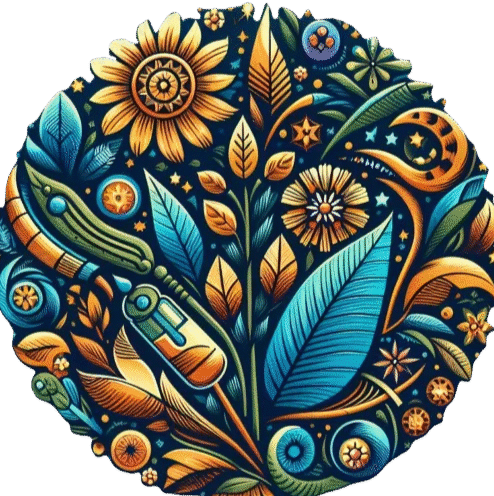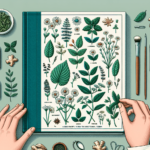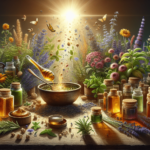So you’re looking for a comprehensive book on herbal remedies, huh? Look no further because “The Complete Guide to Medicinal Herbs” has got you covered. This book is your ultimate resource when it comes to unlocking the healing powers of nature’s botanical wonders. From lavender to ginger, chamomile to turmeric, this guide provides all the information you need to tap into the incredible medicinal properties of herbs. Whether you’re a seasoned herbalist or just a curious beginner, this book will take you on a journey through the world of herbal remedies, empowering you to take control of your health naturally. Get ready to embark on a plant-powered adventure!

Introduction to Medicinal Herbs
Medicinal herbs have been used for centuries to promote health and treat various ailments. These plants, often found in our backyards or easily accessible in herbal markets, provide natural remedies that can enhance our well-being. In this comprehensive article, we will explore the world of medicinal herbs, delving into their history, benefits, and uses, as well as safety precautions to keep in mind when using them.
What are Medicinal Herbs?
Medicinal herbs, also known as medicinal plants or herbs, are plants that are valued for their therapeutic properties and used to treat or alleviate various health conditions. These herbs can be used in different forms like teas, tinctures, extracts, salves, and more. They contain bioactive compounds, such as alkaloids, flavonoids, and essential oils, that give them their medicinal properties.
History of Medicinal Herbs
The use of medicinal herbs dates back thousands of years. Ancient civilizations, such as the Egyptians, Greeks, and Chinese, have long recognized the healing potential of plants. Traditional healing systems, like Ayurvedic medicine and Traditional Chinese Medicine (TCM), have extensively used medicinal herbs for centuries. With the emergence of modern pharmaceuticals, the knowledge of herbal remedies somewhat diminished. However, there has been a resurgence in recent years as people seek natural alternatives to conventional medicine.
Benefits and Uses of Medicinal Herbs
Medicinal herbs offer a wide range of benefits and can be used for various purposes. They can help boost the immune system, relieve pain, reduce inflammation, promote relaxation, support digestion, improve sleep, and much more. Medicinal herbs can be used to address common ailments such as headaches, digestive disorders, insomnia, anxiety, and respiratory problems. Additionally, many herbs have antioxidant properties, which can help protect against oxidative stress and promote overall health.
Safety and Precautions
While medicinal herbs are generally safe, it’s important to exercise caution and be aware of potential interactions and contraindications. Some herbs may interact with medications or have adverse effects in certain individuals. It is advisable to consult with a healthcare professional before incorporating new herbs into your routine, especially if you have pre-existing medical conditions or are taking medications. Additionally, pregnant or nursing women, as well as young children, should exercise extra caution when using medicinal herbs.
Choosing and Growing Medicinal Herbs
Selecting the Right Medicinal Herbs
When choosing medicinal herbs, it’s crucial to select the ones that align with your specific health needs and goals. Research different herbs and their benefits to find the ones that resonate with you. Consider factors such as the herb’s safety profile, effectiveness, and availability. It’s also important to consider your gardening skills and the climate in which you reside, as some herbs may require specific conditions to thrive.
Understanding Growing Conditions
To successfully grow medicinal herbs, it’s crucial to understand their specific growing conditions. Some herbs prefer full sunlight, while others thrive in partial shade. Soil type, moisture levels, and temperature requirements are also important factors to consider. Research each herb’s growing conditions and ensure that you can provide the necessary environment for their cultivation.
Methods of Cultivating Medicinal Herbs
There are several methods of cultivating medicinal herbs, depending on your available space and resources. You can opt for growing herbs in a traditional garden bed, container gardening, or even indoor hydroponic systems. Research the specific requirements for each herb you wish to grow and choose the cultivation method that best suits your needs and resources.
Harvesting and Preserving Medicinal Herbs
Once your medicinal herbs have grown, it’s important to know the proper harvesting techniques to ensure maximum potency. Different herbs have different harvesting periods, and it’s crucial to harvest them at the appropriate time to preserve their medicinal properties. After harvesting, herbs can be preserved through various methods such as drying, freezing, or creating herbal tinctures and extracts. Proper storage techniques are essential to maintain the herbs’ potency and freshness.
Preparing Medicinal Herb Remedies
Basic Tools and Equipment
To prepare medicinal herb remedies, you will need a few basic tools and equipment. These include a mortar and pestle for grinding herbs, a kitchen scale to measure quantities accurately, glass jars for storing herbal preparations, a strainer or cheesecloth for straining infusions, and a double boiler for gentle heating during preparations. It’s important to keep these tools clean and dedicated solely to herbal preparations to avoid contamination.
Understanding Different Preparation Methods
There are various methods for preparing medicinal herb remedies, each suited for different applications and desired outcomes. Common preparation methods include infusions and decoctions, tinctures and extracts, salves and balms, compresses and poultices, herbal teas and tonics, and capsules and tablets. Understanding these methods and their specific use cases will allow you to choose the most appropriate preparation method for your needs.
Infusions and Decoctions
Infusions and decoctions are simple and effective ways to extract medicinal properties from herbs using hot water. Infusions involve steeping herbs in boiling water for a specific period, while decoctions require simmering herbs in water for a longer time. These methods are commonly used for making herbal teas and can be consumed orally or used topically for baths and compresses.
Tinctures and Extracts
Tinctures and extracts are potent concentrated forms of medicinal herbs, typically made by soaking herbs in alcohol or another solvent to extract their active compounds. These preparations are favored for their long shelf life and convenience. Tinctures and extracts can be easily measured, diluted, or added to other preparations, making them versatile and effective methods for administering herbal remedies.
Salves and Balms
Salves and balms are semi-solid preparations that are applied topically to the skin. They are typically made by combining herbal-infused oils with beeswax or another thickening agent. Salves and balms provide a convenient way to deliver herbal benefits directly to affected areas, such as soothing skin irritations or promoting wound healing.
Compresses and Poultices
Compresses and poultices involve applying herbal preparations directly to the skin to treat localized conditions. Compresses are made by soaking a cloth in an herbal infusion or decoction and applying it to the affected area, while poultices are created by crushing or blending fresh or dried herbs and applying them directly to the skin. These methods are useful for treating inflammation, relieving pain, and promoting healing in specific areas.
Herbal Teas and Tonics
Herbal teas and tonics are commonly consumed orally to support various aspects of health. Herbal teas are made by infusing herbs in hot water and can be enjoyed hot or cold. Tonics are more concentrated and often made by simmering herbs in water for an extended period. Herbal teas and tonics are a soothing and accessible way to incorporate medicinal herbs into your daily routine or address specific health concerns.
Capsules and Tablets
For those who prefer a more convenient and standardized method of taking medicinal herbs, capsules and tablets are available. These pre-measured forms allow for easier consumption and accurate dosing. However, it’s important to note that not all herbs are suitable for encapsulation or tablet formulation, and it’s recommended to consult a healthcare professional or follow reputable guidelines to ensure proper dosage and quality.
Common Medicinal Herbs and Their Uses
Aloe Vera
Aloe vera is well-known for its soothing and healing properties, particularly for the skin. It can be used topically to soothe sunburns, minor cuts, and irritations. Aloe vera gel is also available as a commercial product and is commonly used in skincare and cosmetic preparations.
Chamomile
Chamomile is a popular herb known for its calming and relaxing effects. It is commonly consumed as a tea to promote sleep, reduce anxiety, and aid digestion. Chamomile can also be used topically as a compress or poultice for soothing skin irritations or eye inflammations.
Echinacea
Echinacea is often used as a natural remedy to boost the immune system and support overall health. It is commonly consumed as a tea or taken in tincture or capsule form to help prevent and alleviate symptoms of the common cold and flu. Echinacea is also believed to have anti-inflammatory properties.
Ginger
Ginger has been used for centuries to support digestion and relieve nausea. It is commonly consumed as a tea or added to dishes for its spicy flavor and digestive benefits. Ginger can also be made into a compress or used in salves for relieving muscle pain and reducing inflammation.
Lavender
Lavender is well-known for its soothing and relaxation properties. It is commonly used in aromatherapy to promote sleep and reduce anxiety. The essential oil of lavender can be used topically for its calming effects, and lavender-infused oil can be used in balms and salves for skin irritations and minor wounds.
Peppermint
Peppermint has a refreshing and cooling effect, making it a popular herb for digestive ailments such as indigestion, bloating, and nausea. Peppermint tea is commonly consumed as a digestive aid. The essential oil of peppermint can also be used topically for relieving muscle tension and headaches.
St. John’s Wort
St. John’s Wort has long been used as a natural remedy for mild to moderate depression and anxiety. It is commonly consumed as a tea or taken in capsule form. However, it’s important to note that St. John’s Wort may interact with certain medications, so consulting a healthcare professional is advised.
Turmeric
Turmeric is a vibrant yellow spice widely recognized for its potent anti-inflammatory and antioxidant properties. It is commonly consumed in curries and other dishes, and its active compound, curcumin, is also available in capsule form. Turmeric can be used to support joint health, reduce inflammation, and support overall well-being.
Valerian
Valerian is frequently used as a natural remedy for sleep disorders and anxiety. It is commonly consumed as a tea or taken as a tincture or capsule. Valerian has a relaxing effect and can help promote restful sleep without causing drowsiness in the morning.
Yarrow
Yarrow is a versatile herb used for its anti-inflammatory and wound-healing properties. It can be used topically as a compress or poultice for treating minor wounds, relieving itching, and reducing inflammation. Yarrow can also be consumed as a tea to support digestion and alleviate menstrual cramps.
Herbal Remedies for Common Ailments
Headaches and Migraines
Herbal remedies for headaches and migraines include feverfew, which can help reduce the frequency and severity of migraines, and peppermint, which has analgesic properties that can alleviate headache pain. Lavender essential oil can also be beneficial for tension headaches when applied topically or used in aromatherapy.
Digestive Disorders
For digestive disorders such as indigestion, bloating, and constipation, herbs like ginger, peppermint, chamomile, and fennel can provide relief. These herbs can be consumed as teas or added to dishes for their digestive properties. Dandelion root is another herb that can support liver function and aid digestion.
Insomnia and Sleep Disorders
Herbal remedies for insomnia and sleep disorders include chamomile, valerian, lavender, and passionflower. These herbs have calming and sedative properties that can promote relaxation and improve sleep quality. Consuming herbal teas or taking herbal tinctures before bedtime can help enhance sleep.
Anxiety and Stress
To help manage anxiety and stress, herbs such as ashwagandha, lemon balm, passionflower, and chamomile can be beneficial. These herbs have relaxing properties that can help reduce anxiety and promote a sense of calm. Consuming teas, tinctures, or capsules made from these herbs can support stress relief.
Colds and Flu
Herbal remedies for colds and flu include herbs such as echinacea, elderberry, ginger, and garlic. Echinacea can help enhance the immune system’s response to infections, while elderberry is known for its antiviral properties. Ginger and garlic can provide immune-boosting and soothing effects.
Skin Conditions
For various skin conditions such as acne, eczema, or minor wounds, herbal remedies can provide relief. Aloe vera gel, lavender-infused oil, calendula, and tea tree oil are commonly used herbs for skin conditions. These herbs have anti-inflammatory, antimicrobial, and wound-healing properties.
Pain Relief
Herbs such as turmeric, devil’s claw, white willow bark, and arnica can help alleviate pain from conditions like arthritis, muscle soreness, and inflammation. These herbs have analgesic and anti-inflammatory properties. Herbal remedies like salves, balms, or tinctures can be applied topically to affected areas for pain relief.
Menstrual Issues
For menstrual issues such as cramps, irregular periods, or PMS symptoms, herbs such as raspberry leaf, chamomile, ginger, and yarrow can provide relief. Raspberry leaf tea can help support a healthy menstrual cycle, while chamomile and ginger can alleviate cramps and promote relaxation.
Respiratory Problems
Herbal remedies for respiratory problems like coughs, congestion, and bronchitis include herbs such as mullein, thyme, eucalyptus, and licorice root. These herbs have expectorant, antiviral, and soothing properties. Herbal teas, tinctures, or inhalations can provide relief for respiratory symptoms.
Combining Medicinal Herbs
Understanding Herb Interactions
When combining medicinal herbs, it’s important to understand potential interactions between herbs and any medications you may be taking. Some herbs can enhance or reduce the effectiveness of certain medications or have adverse effects when combined. It’s advisable to consult a healthcare professional or herbalist for guidance when creating herbal blends to ensure safety and efficacy.
Formulating Effective Herbal Blends
Formulating effective herbal blends involves considering the desired therapeutic effects and the synergistic properties of different herbs. Some herbs have complementary actions, enhancing each other’s benefits and creating a stronger overall effect. Experimenting with different combinations and proportions can help create personalized herbal blends tailored to your specific health needs and preferences.
Synergistic Effects of Herb Combinations
Certain herb combinations exhibit synergistic effects, where the combined herbal blend provides greater benefits than each herb individually. For example, combining turmeric with black pepper enhances the absorption and bioavailability of turmeric’s active compound, curcumin. Similarly, combining herbs with different properties, such as sedative and stimulant herbs, can create a balanced and harmonious effect.
Herbal Remedies for Children and Pets
Child-Friendly Herbs and Dosages
When using herbal remedies for children, it’s important to consider their unique needs and adjust dosages accordingly. Some child-friendly herbs include chamomile, catnip, lemon balm, and marshmallow root, which can help soothe common childhood ailments like colic, teething discomfort, and restlessness. It’s essential to research appropriate dosages or consult a pediatrician or herbalist for guidance when using herbs with children.
Herb Safety for Pets
When using herbal remedies for pets, it’s crucial to ensure that the herbs used are safe for their species and appropriate for their specific condition. Some herbs, like chamomile and lavender, can be used for pets to promote relaxation and soothe skin irritations. However, it’s important to research pet-safe herbs and their proper dosages or consult with a veterinarian or holistic veterinarian before using herbal remedies for pets.
Common Pet Ailments and Remedies
Common pet ailments such as anxiety, digestive issues, skin irritations, and minor wounds can benefit from herbal remedies. For anxiety, herbs like valerian, chamomile, and passionflower can be used. For digestive issues, herbs such as ginger, peppermint, and fennel can provide relief. Calendula and aloe vera gel can be used for soothing skin irritations, while calendula-infused oil can promote wound healing in pets.
Alternative Medicine and Traditional Healing Systems
Ayurvedic Medicine
Ayurvedic medicine is a traditional healing system that originated in India over 5,000 years ago. It focuses on achieving balance and harmony in all aspects of life, including physical, mental, and spiritual well-being. Ayurvedic herbal remedies often incorporate herbs such as ashwagandha, turmeric, holy basil, and triphala to address various health concerns.
Traditional Chinese Medicine
Traditional Chinese Medicine (TCM) is an ancient healing system that has been practiced for over 2,500 years. It emphasizes the balance of yin and yang energies and the flow of Qi (life force) in the body. Herbal remedies play a significant role in TCM, with herbs like ginseng, astragalus, goji berries, and licorice root being commonly used to restore balance and promote health.
Native American Herbalism
Native American herbalism encompasses various indigenous healing traditions across North America. It emphasizes the interconnectedness of humans and nature and the use of plants as sacred medicine. Native American herbal remedies often incorporate herbs such as sage, cedar, sweetgrass, and white pine for purification, healing rituals, and addressing specific health concerns.
Other Traditional Healing Systems
Other traditional healing systems around the world, including African, Mediterranean, and South American indigenous healing traditions, also utilize medicinal herbs. These systems often have their unique approaches and herb selections based on regional availability and cultural practices. Exploring these traditions can provide a deeper understanding of the diverse uses and benefits of medicinal herbs.
Resources for Medicinal Herb Enthusiasts
Recommended Books and References
There are numerous books and references available to expand your knowledge of medicinal herbs. Some recommended books include “The Herbal Medicine-Maker’s Handbook” by James Green, “Rosemary Gladstar’s Medicinal Herbs: A Beginner’s Guide” by Rosemary Gladstar, and “The Earthwise Herbal: A Complete Guide to Old World Medicinal Plants” by Matthew Wood. These books offer valuable information and guidance on using medicinal herbs.
Online Communities and Forums
Engaging with online communities and forums can provide a platform for sharing knowledge and experiences with fellow medicinal herb enthusiasts. Websites such as HerbMentor, The Herbarium, and various Facebook groups focused on herbal medicine offer opportunities to connect with others, ask questions, and learn from experienced herbalists.
Local Herb Shops and Nurseries
Local herb shops and nurseries can be excellent resources for finding high-quality medicinal herbs and connecting with knowledgeable staff. They often carry an array of dried herbs, as well as herbal preparations and products. Visiting these establishments allows you to ask questions, receive personalized advice, and support local businesses.
Courses and Workshops
Attending courses and workshops on herbal medicine can provide in-depth knowledge and hands-on experience with medicinal herbs. Many herbalists and educational institutions offer online and in-person courses covering various topics, from basic herbalism to advanced formulation techniques. Some renowned herbalism schools include the American Herbalists Guild, Chestnut School of Herbal Medicine, and East West School of Planetary Herbology.
Conclusion
Embracing the power of medicinal herbs can enhance our health and well-being naturally. By understanding the history, benefits, and uses of medicinal herbs, we can integrate these natural remedies into our lives. Whether it’s growing your own herbs, preparing herbal remedies, or exploring traditional healing systems, the world of medicinal herbs offers a vast array of possibilities for health and vitality. By taking the time to learn and experiment with different herbs, we can tap into the healing wisdom of nature and enhance our overall quality of life.





